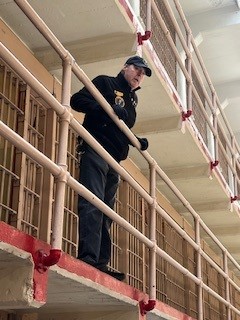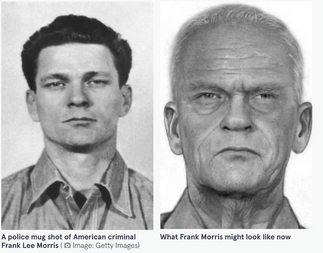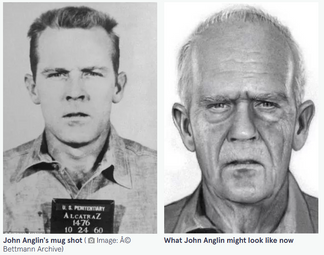Jailbreaks and Christmas Ornaments
It’s that most wonderful time of the year when you are faced with the blank slate of a Christmas tree. The family gathered recently and dove into the boxes of memories, delicate ornaments gathered across the span of lifetimes. We didn’t wait for St. Nicholas or anyone to put on a kerchief or cap. We hung those trinkets with care before even the Thanksgiving turkey showed up.
One of our newest commemorative baubles is Alcatraz. Yes, THAT Alcatraz, the prison, The Rock! The moody guardian of San Francisco Bay hangs from our cheery Christmas tree. A replica with a bit of an attitude. If you look closely, even The Rock ornament seems to still be mad about a prison break that may or may not have been successful.

Jan and I visited Alcatraz as one of the “must sees” on our whirlwind vacation to Northern California in the fall. We probably didn’t give ourselves enough time to see everything, but what we did left an impression of awe and some reverence at what the inmates went through in this most famous of American prisons. There are other California prisons of note, San Quentin because of Merle Haggard’s attendance, and Folsom, where Johnny Cash first heard that train a’comin’… Nevertheless, even a half century after closure Alcatraz remains at top of mind when you say the word “prison”.
The only way to get to Alcatraz has always been by boat. Alcatraz literally sits on huge rocks in San Francisco Bay, about 1.25 miles from the north shore of the city. These days there is a charter boat that runs about every half hour from Pier 33, near the intersection of the Embarcadero and Bay Streets.
A mile and a quarter may not sound too impressive. I’m certain I couldn’t swim it, but there are people who swim the 20 miles across the English Channel. As we motored over to the prison, I wondered why prison officials had been so adamant in stating nobody had ever successfully escaped Alcatraz.
One reason I learned later that day when we took a Catamaran ride is the waters of San Francisco Bay are frigid, generally averaging between 45-and-60 degrees Fahrenheit. During the prison tour, we were told the inmates could not take a cold shower, only hot ones. The warden did not want to give them a chance to get acclimated to cold water. If they tried to escape, the bay waters would be an extra shock to their system.

As the ferry boat pulled into the dock area at Alcatraz, I was surprised to see a huge sign reading “Indians Welcome” and claiming Alcatraz as Indian land. As a person with Cherokee blood about five generations prior, my heart was warmed to hear of the capture of the prison. Upon landing, I discovered the truth was a more familiar tale.
According to Wikipedia, “The Occupation of Alcatraz (November 20, 1969 – June 11, 1971) was a 19-month long occupation by 89 Native Americans and their supporters of Alcatraz Island and its prison complex, classified as abandoned surplus federal land. The occupation was led by Richard Oakes, LaNada Means, and others, while John Trudell served as spokesman. The group lived on the island together until the occupation was forcibly ended by the U.S. government.”

I envisioned John Wayne and a double column of blue-coated calvary from “She Wore A Yellow Ribbon” showing up from Hollywood and moving the squatters along. When I think of the lands the Native Americans were forced to give up, neither Oklahoma nor Alcatraz seems a fair trade.
Probably the most powerful portion of the cell block tour was the demonstration of the global locking system. A guide, dressed like an Alcatraz guard, first unlocked all the cells in the block, then locked them again. The clanging roar of sound was terrible, even for the assembled tourist crowd on the outside. I could only imagine the doomsday sound of hopelessness for one incarcerated on the other side of the bars.
We were fascinated by all the famous names who had resided in the Alcatraz cells. Probably best known was Al Capone, the kingpin of Chicago crime during the Roaring 20s. He was convicted of tax evasion and led a much more austere life on The Rock. Tax evasion was also what tripped up another famous gangster, Meyer “Mickey” Cohen, who earned a trip to Alcatraz, and was the only inmate ever bailed out of the prison. His bond was signed by Earl Warren, then chief justice of the Supreme Court. Cohen was the mob’s “political” genius, who must have used some of his talent to reach high places.
There was also Robert Stroud, “The Birdman of Alcatraz”, who turns out only raised birds while at Leavenworth Penitentiary. He had become a noted ornithologist until transferred in 1942 to Alcatraz, where regulations did not allow him to have any birds. He died “birdless” in 1959, still in custody after 50 years behind bars. Burt Lancaster played him in a 1962 movie that ignored the fact he had no birds while at Alcatraz. I guess “The Birdman of Leavenworth” didn’t have the same ring for marketability.

George “Machine Gun” Kelly was from a good Memphis family, but married Kathryn Thorne, a woman who was already an experienced criminal. She introduced her husband to crime and bought him the Thompson machine gun that lent him a great nickname. Her love and mentorship led them to rival Bonnie and Clyde in infamous misdeeds and landed him a room at Alcatraz.
I think the most interesting inmates for Jan and I were Frank Morris and brothers John and Clarence Anglin. This trio may or may not have made the only successful escape of Alcatraz in 1962. The men dug out of their cells with sharpened spoons, built fake heads with hair from the barber shop to fool the guards into thinking they were sleeping and exited The Rock on a makeshift raft made of 50 old raincoats. No bodies were ever found, though the official story was the escapees had drowned.
Maybe sharks got the bodies?
The Anglin family insist the story of the death of their kinsmen was a coverup. The Anglins contend the trio was picked up by a boat arranged by Mickey Cohen and escaped to South America to live out the rest of their lives. Another Anglin brother on his deathbed admitted to being in contact with his siblings for 25 years after the escape.
So, what is an intrigued tourist to believe?
The mystery of what happened was tailor-made for Hollywood. And who better to play Frank Morris, the mastermind with a 133 IQ, than Clint Eastwood? Clint starred in the 1979 film, “Escape from Alcatraz” that laid out the known facts about the escape. I had seen it many years before, but Jan and I rented the movie when we got home to help us decide. Did they or didn’t they escape?
We were dismayed the film ended with the trio in the water on the flimsy raft made from raincoats. There was no resolution or even a hint of what might have happened one way or another. The Alcatraz tourist or movie viewer is left to make up their own mind.
We decided the trio escaped successfully because of these four factors:
1) The idea there was aid from Mickey Cohen’s outside gangster contacts in the form of a boat. I had often wondered, even if they got to shore in the flimsy raft, they would have needed help to get further. I had not considered organized crime as a possibility until reading a story about the Anglin family where that possibility was raised. Organize crime can be very organized and successful.
2) The fact Alcatraz was closed within a year of their escape. You don’t bail on a winning team. The prison’s aura of invincibility had been pierced, and it was closed before others followed the trio’s example.
3) The waters of San Francisco Bay don’t seem insurmountable. Right after visiting Alcatraz, we took a Catamaran ride around the bay. It was plenty windy, and the water was cold as advertised. I wouldn’t have wanted to be on the water in a raft made from old raincoats. Still, there were people frolicking in the water by choice, a long way from the shore. We didn’t see any human popsicles bobbing in the bay.
4) The presence of Clint Eastwood in the movie. Everybody knows you don’t pull on Superman’s cape or mess with Clint Eastwood. Clint wouldn’t have portrayed a loser. Clint thought Frank Morris and his buddies escaped or he wouldn’t have taken the part.
A Photo array of the trio, then and now (?)


































